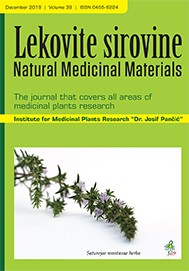Faculty of Biology, Institute of Botany and Botanical Garden “Jevremovac”, University of Belgrade , Belgrade , Serbia
Faculty of Biology, Institute of Botany and Botanical Garden “Jevremovac”, University of Belgrade , Belgrade , Serbia
Faculty of Biology, Institute of Botany and Botanical Garden “Jevremovac”, University of Belgrade , Belgrade , Serbia
<i>Ocimum basilicum<i> (sweet basil) and <i>Laurus nobilis</i> (bay leaves or laurel) have been used in traditional medicine for centuries, and also extensively employed as spices for adding aroma and flavor to various food products. <i>Citrus reticulata</i> (mandarin) is mainly used in food industry for juice production, while its peel as main byproduct contains high concentration of valuable substances. The samples were collected in Lastva Grbaljska (Montenegrin coast) and purchased from the market. Since the oxidative stress results in development of numerous diseases, among them neurodegeneration and diabetes, the antioxidant activity, antineurodegenerative and antidiabetic activities were analyzed, aiming to compare potential of plants cultivated under natural conditions and commercially purchased from the market, as well as to compare the effect of different solvents applied in the extraction process. Water, methanol and acetone extracts of leaves and peel were tested by DPPH and total reducing power (TRP) methods for determination of antioxidant activity, and by acetylcholinesterase (AChE) and α-glucosidase inhibition assays for analyzing the other activities. Total phenolic (TPC) and flavonoid (TFC) contents were also determined. The acetonic extract of <i>L. nobilis</i> from Lastva showed the highest TPC, DPPH, TRP, and α-glucosidase inhibition, while water extract of commercial <i>L. nobilis</i> exhibited the highest AChE inhibition. The leaves of <i>L. nobilis</i> are demonstrated to be promising antioxidant, antineurodegenerative and antidiabetic agent.
This is an open access article distributed under the Creative Commons Attribution License which permits unrestricted use, distribution, and reproduction in any medium, provided the original work is properly cited.

The statements, opinions and data contained in the journal are solely those of the individual authors and contributors and not of the publisher and the editor(s). We stay neutral with regard to jurisdictional claims in published maps and institutional affiliations.